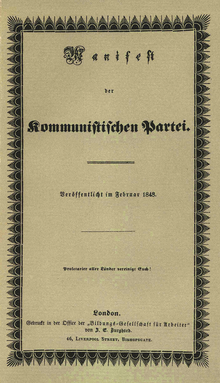
A manifesto is a written declaration of the intentions, motives, or views of the issuer, be it an individual, group, political party, or government.[1][2][3][4] A manifesto usually accepts a previously published opinion or public consensus or promotes a new idea with prescriptive notions for carrying out changes the author believes should be made. It often is political, social or artistic in nature, sometimes revolutionary, but may present an individual's life stance. Manifestos relating to religious belief are generally referred to as creeds or confessions of faith.
Etymology[edit]
It is derived from the Italian word manifesto, itself derived from the Latin manifestum, meaning clear or conspicuous. Its first recorded use in English is from 1620, in Nathaniel Brent's translation of Paolo Sarpi's History of the Council of Trent: "To this citation he made answer by a Manifesto" (p. 102). Similarly, "They were so farre surprised with his Manifesto, that they would never suffer it to be published" (p. 103).[5]
Famous examples[edit]
- The Communist Manifesto (1848) by Karl Marx and Friedrich Engels
- Mein Kampf (1925) by Adolf Hitler
- Industrial Society and Its Future (1995) by Theodore John Kaczynski
See also[edit]
References[edit]
- ^ Merriam-Webster online dictionary definition of Manifesto Archived August 8, 2012, at the Wayback Machine.
- ^ "SEOphonist | die SEOphonisten Wahl 2013" (in German). Archived from the original on September 12, 2013. Retrieved September 14, 2013., article on "Wahlprogramm", literally "election programme".
- ^ Dictionary.com definition of Manifesto Archived August 6, 2012, at the Wayback Machine.
- ^ David Robertson, The Routledge Dictionary of Politics, Edition 3, Psychology Press, 1890 p. 295 Archived April 25, 2016, at the Wayback Machine, ISBN 0415323770, 9780415323772
- ^ Oxford English Dictionary
Well, that’s interesting to know that Psilotum nudum are known as whisk ferns. Psilotum nudum is the commoner species of the two. While the P. flaccidum is a rare species and is found in the tropical islands. Both the species are usually epiphytic in habit and grow upon tree ferns. These species may also be terrestrial and grow in humus or in the crevices of the rocks.
View the detailed Guide of Psilotum nudum: Detailed Study Of Psilotum Nudum (Whisk Fern), Classification, Anatomy, Reproduction